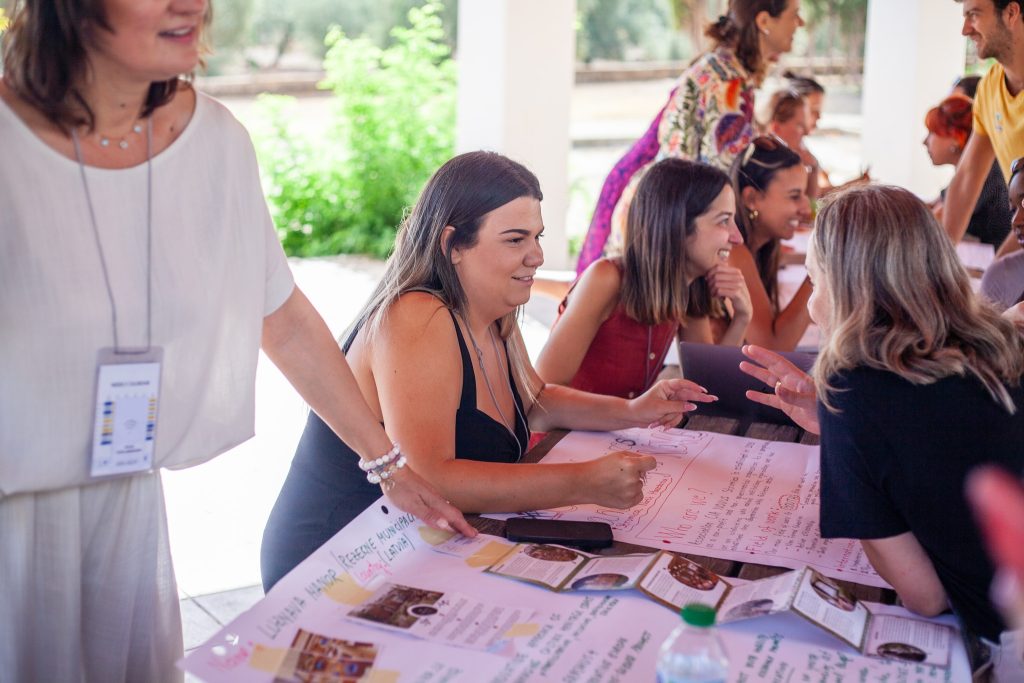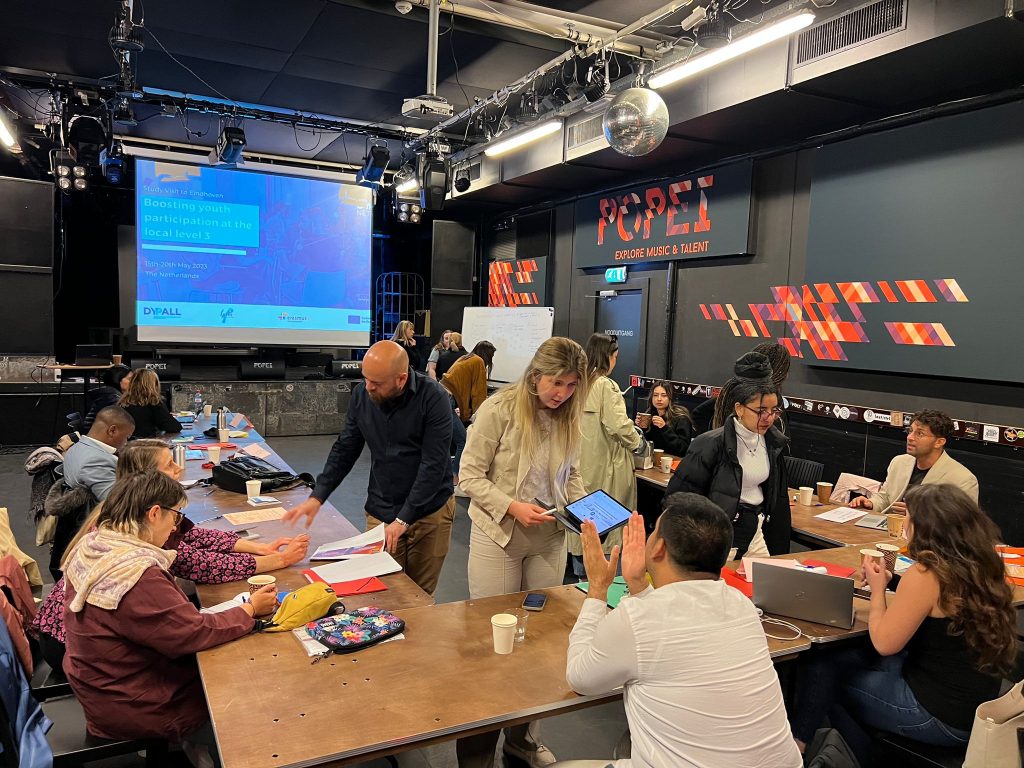
We enjoyed interviewing Marija Krstevska Taseva, Project Manager from Dypall Network. She told us more about the organization, its mission, and activities, and its good practice – Quality Charter on Participatory and Inclusive Local Youth Councils. We also learned more about their upcoming activities.
How would you describe DYPALL’s main field of activity?
DYPALL Network’s primary focus is on fostering youth participation in decision-making processes at the local level. Comprising over 80 organizations and local authorities across more than 30 countries across Europe and the broader, the organization proactively engages young individuals in cooperative initiatives alongside municipal and regional authorities. By doing so, DYPALL addresses the challenges of bridging the gap between youth and local governance, on the one hand, by building the capacity of young people and, on the other hand, by enabling the authorities to effectively address the needs and interests of young individuals and cultivating sustainable youth policies within communities.
What issues and challenges in the local youth work is the organization helping to solve?
DYPALL Network strategically tackles youth exclusion and disengagement issues, aiming to build trustful structures and encourage active participation in democratic processes. We offer training programs, research, and consultancy services, all aligned with empowering young people, enhancing the competencies of local officers, and advocating for impactful changes in national and European youth policies. Through these efforts, DYPALL also contributes to creating more inclusive and democratic spaces, both physical and digital, where youth can play a vital role in shaping their local communities.

Why are Local Youth Councils important, and how do you help develop and promote them?
Local Youth Councils (LYCs) are one of the structures for meaningful youth participation that play a pivotal role in enhancing democracy at the local level. Their importance lies in empowering young people to share diverse youth perspectives, advocate for issues relevant to the community, and engage in the decision-making processes. Local youth councils are also mechanisms for developing informed, skilled, and active young people who contribute to positive changes in communities.
We believe that the local youth councils can have huge potential, especially in reaching out to marginalized youth who have something to say and can bring different perspectives on local issues but are usually not involved in such structures. One of the projects that we are currently implementing is ‘Local Youth Councils at International Scale (LYCIS)’. This project aims to raise the capacity of youth organizations, youth workers, youth leaders, and young people to create sustainable, inclusive, quality local youth councils. It’s based on the experience of different European and South-Mediterranean Countries. In the framework of this project, the Quality Charter on participatory and inclusive local youth councils was created.

Could you explain more about the Quality Charter tool and how it contributes to the quality of youth work?
The Quality Charter on participatory and inclusive local youth councils is an assessment tool designed to be used by the local youth council members, youth workers or municipality officers, The can use it when building, rebuilding, reforming or relaunching a local youth council. It provides concrete indicators for evaluating the youth council’s structure and functioning to make it more participatory and inclusive, but also to increase its impact. Moreover, the Quality Charter aims to empower a long-term strategy for sustainable continuous improvement of the local youth councils and their impact on local, regional and international levels.
What type of assessments does the Charter provide?
These are 3 areas of assessment (AoA): LYC for fair youth participation, LYC for meaningful and impactful youth participation, and LYC for sustainable youth participation. Then, each AoA has 3 criteria dimensions, and in each criteria, there is a number of specific indicators. Each indicator is specific enough to be clearly assessed but also general enough to be adaptable to the local specificities. That’s why the rating scale of assessment has the option ‘not applicable’ besides ‘not at all’, ‘partially’, and ‘fully’. An important feature is the ‘Note to self’ part of this assessment tool, which is a space where those who are using the Quality Charter can put notes to themselves on what they are doing well or what they still need to do so they use the tool as an inspiration for drafting their strategic improvement plan.
Could you share some examples of the indicators?
Here are some examples of the indicators in our tool:
1.1.2 – LYC represents different interest groups in the community (different youth NGOs, environment activists, sports, cultural, youth from marginalized or underrepresented groups, such as LGBTQ+ youth, minority ethnic groups, individuals with disabilities, youth from low-income backgrounds, etc.)
2.2.4 – LYC provides recommendations and raises awareness on various issues affecting young people among policymakers and the broader community
3.1.1 – LYC considers and consults a broader audience of young people to assess their opinions on the role and decisions of the LYC as well as regarding their needs and interests to feed future actions

And what are some new activities?
We have a brand new project, and it’s tackling a similar topic. It’s called ‘Climbing the Ladder: Fostering a Culture of Youth Engagement’, and it addresses the need for effective and meaningful structures, mechanisms, and spaces for the active engagement of young people in policy-making and decision-making processes at local, regional, national, and European levels. Some of the key objectives of the project are to:
– Analyze and understand the key features of current models and mechanisms for youth engagement in Europe;
– Collect and share successful practices that encourage young people, policymakers, and practitioners to involve the youth perspective in policy-making;
– Create an accessible platform for implementing youth engagement mechanisms;
– Establish two networks (of young facilitators and counselors for democracy) to promote citizen participation and democratic engagement at the local and regional levels in Europe.
What are the expected outcomes of this project?
One of the most interesting outcomes of this project is the digital platform, which will provide qualitative guidelines for the design and implementation of mechanisms of youth engagement. The whole process will be immersive and engaging. Users, including local authorities, young people, and youth workers, will enter the digital platform, register, and select their profile information first. Then they will draft a desired process, answer questions about its purpose and target audience, and the platform will provide the best matching structure to these needs. For example: a steering group, advisory board, co-management body, focus group, etc. along with a set of digital qualitative guidelines to establish and run such a structure in the specific reality.

What else is coming up at DYPALL in the coming year?
In the upcoming year, we’ll be offering a diverse range of activities, as usual, with a primary emphasis on enhancing youth participation at the local level. We will be introducing a new initiative, “Phygital Youth Participation – Digital Innovation for Stronger Local Democracies.” This innovative project is centered around the concept of ‘phygital,‘ seamlessly blending digital tools with physical spaces. Through this project, we’re pioneering a fresh approach to youth dialogue within communities. Currently, our focus lies on developing a cutting-edge phygital tool designed to engage young people in sharing their perspectives and opinions in a manner that’s both accessible and youth-friendly. During this year, we’ll be piloting this tool. Besides that, we’ll organize an international training session equipping youth workers from municipalities and civil society organizations with the skills to effectively utilize this digital tool within a ‘phygital’ context.